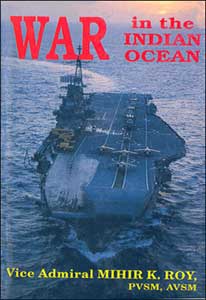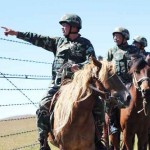 The RN ships turned back from the vicinity of the Maldives and in hindsight kudos should be given to the British High Commission where the Naval Advisor kept himself fully informed of the need to protect British ‘interests and investments in both segments of Pakistan. This was in stark contrast to the United States authorities who refused to see the writing on the wall of the confrontation between a democracy and a military dictatorship.
The RN ships turned back from the vicinity of the Maldives and in hindsight kudos should be given to the British High Commission where the Naval Advisor kept himself fully informed of the need to protect British ‘interests and investments in both segments of Pakistan. This was in stark contrast to the United States authorities who refused to see the writing on the wall of the confrontation between a democracy and a military dictatorship.
Mining the Pusur river entrance
The Mukti Bahini naval forces were elated with the success of their riverine operations which prevented external supplies reaching the beleaguered Pakistan Army. However, Greek and, Panamanian ships flying the flags of convenience continued to bring in supplies as they were attracted by the ‘high war-risk rates’.
The frogmen then mined the entrance near the fairway buoy on the Pusur river. They used a submarine-delivered mine with a ship-count mechanism which was possibly smuggled out of the Chittagong Ordinance depot and very akin to the ones embarked by Ghazi.
The explosion of the vessel striking the mine was dramatic. No lives were lost but the vessel went to the bottom partly blocking the navigable channel.
The first victim of this innovative mining operation was the Greek freighter Chrysovalendu which had defied local sentiments by bringing in much-needed military supplies at lucrative cargo rates. The explosion of the vessel striking the mine was dramatic. No lives were lost but the vessel went to the bottom partly blocking the navigable channel.
The morale of the security forces dipped to an all-time low. The port authorities marked a narrow channel and doubled the security measures. However, another Greek freighter, the 8000-ton Mastrostellos which also tried to run the gauntlet, struck another mine and lay disabled thus completely blocking the Pusur channel. A remarkable achievement without using a mine layer or even a suitably converted vessel as there was none in the area. The Port Director formally closed the second largest port in East Pakistan – a recognition of the highly motivated and effective Mukti Bahini maritime wing, which merits this saga being further investigated and carved into the history of the liberation of Bangladesh.
November tote
The November attack by 172 waterborne guerrillas with each pair of frogmen now carrying two limpet mines and hand grenades were more effective. The operations were switched from night to early mornings to take advantage of the winter river mist and poor visibility. The frogmen led by Lieutenant Zia neutralized the Gabkhan canal. The mini bulk carrier, Minilabour was disabled at Khulna and the Columbia Trader at Mongla in spite of continuous aerial reconnaissances by light aircraft and helicopters.
Two frogmen failed to rendezvous after the attack and it is presumed they made the ultimate sacrifice. The freighter Mercara and Skyter were extensively damaged.
The Somalian freighter Berlion was also attacked in Khulna. Siddiqui’s (not Tiger Siddiqui) cavaliers sank an inland water tanker and a large barge at Chittagong. Two frogmen failed to rendezvous after the attack and it is presumed they made the ultimate sacrifice. The freighter Mercara and Skyter were extensively damaged.
In Narayanganj, the coaster Minilion with 800 tons of wheat as also a motor launch and a ferry were sunk. At Chandpur, Sharif and Bura Miah, captured three large barges and sank the coaster MV Shamy. The Chandpur power house was also attacked. At Tarorhat and Mohanpur, Imam and Rahman sank the coaster Lili and another smaller vessel. At Alashpur, the frogmen sank the inland waterways vessel, Jaipur and the large self-propelled barge Gafoor. The launches Subhan and Kalpana were captured. At Bhadur Ghat, a largesized barge and steamer were sunk.
At Barisal, Alam and Kutubdin affixed limpets near the waterline of MV Slettar and Africa Proctor and hurriedly left the scene as the ebb had commenced. Sentries on board noticed the exposed limpets and removed the explosives.
The kills rose to 20,000 tons sunk and another 18,000 tons damaged in November 1971. Eid was celebrated mainly by Bihari Muslims and West Pakistani soldiers. The Bengalis carried on with their dedicated task of liberating their motherland and gave no respite to their ruthless oppressors who found it difficult to proclaim to their overlords in Islamabad that there was any semblance of normalcy.
| Editor’s Pick |
This small band of waterborne guerrillas, albeit literally like fish in water, brought the major ports of Chittagong, Chalna, Mongla and Khulna to a standstill. They effectively paralysed the vital inlandwaterways transport system of estuarine East Bengal. The Port Directors closed the ports. Foreign companies put an embargo on their ships entering East Pakistan ports. The Lloyd’s casualty list in London could not be doubted and soaring insurance rates made it uneconomic for even ships under ‘flags of convenience’ to exploit the high cargo rates. But before another sledgehammer attack could be delivered, conflict with India broke out and the Mukti Bahini naval forces joined up with the Indian Border Security Force to liberate ports and waterways of their beloved ‘Sonar Bangia’.
December Liberation — Force Alpha Enters Khulna
With the outbreak of hostilities between India and Pakistan on 3 December 1971, two Mukti Bahini vessels arrived at the Border Security base at Hasnabad on 6 December 1971. The Commandant of the 72 Battalion Marine Special Force, Commander H. K Mukerjee, IN (Retd), fuelled, stored and provided guides to the two Mukti Bahini vessels which were provided with communication sailors and wireless sets.
The Bengalis carried on with their dedicated task of liberating their motherland and gave no respite to their ruthless oppressors who found it difficult to proclaim to their overlords in Islamabad that there was any semblance of normalcy.
Frogmen with demolition stores were then embarked. The BSF vessel, MV Chitrangada and the Naval Seaward defence boat, INS Panvel, were added to this force.
Force Alpha secures an identity
Commander M. N. Samant of the Indian Navy was appointed as the senior officer of ‘Force Alpha’ with instruction to liberate the Khulna, Mongla and Chalna. A large yellow cloth (15′ x 10′) was to be permanently displayed on the bridge of the vessel as an air recognition signal for both Indian Army and Air Force units advancing in this area. Strict wireless silence was to be maintained during the passage to Akram PT via the Sunderbans.





1 Mukti Bahini Naval HERO = 10 DARPOOK-Surrendered P0rkistani sailors.
1971 Bangladesh Liberation War showed that Darpook Porkistan Army/ Air Force/ Navy morale would not stand more than a couple of hard blows at the right time and place.
SALUTE to Bangladesh Naval Commandos (Mukti Bahini Frogmen) and 1971 Indian Navy.
In 1980s, at Dhaka I met several Mukti Bahini Naval Commandos (in Bangladesh they are called as ”Nou/ Naval Commando”) and listened their experience in Pakistan Navy, 1971 heroic operations against Genocidal Pakistan Army/ Navy/ Air-Force in occupied Bangladesh. They were very simple persons and all exprssed their gratitude to India for all the help during the darkest period of Bangladesh.